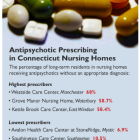I-Team In-Depth
State Nursing Homes Pilot Alarm-Free Initiative — Carefully
|
When Florence Bolella, director of nursing at Kimberly Hall South nursing home in Windsor, told her staff to remove all the alarms from patients, fear and panic set in. Not among the residents, who were relieved to be free of the annoying beeps and squawks that sounded every time someone with mobility problems moved, but among the nurses’ aides. “The CNAs were so afraid they were going to get in trouble if a patient fell,” Bolella recalled. “It took us almost a year to remove 33 alarms. I eventually had to lock up the alarms, so the staff would stop using them.”
In the two years that the nursing home has stopped using both alarms and restraints, it has seen a decline in the number of falls. Bolella isn’t surprised: “I never felt the alarms were effective.”
Kimberly Hall South is among a handful of nursing homes in Connecticut that have gone “alarm-free,” meaning residents at risk of injury, usually from falls, are no longer outfitted with detectors on their mattresses, chair pads and clothing that emit a warning signal when they try to get up and move around.
